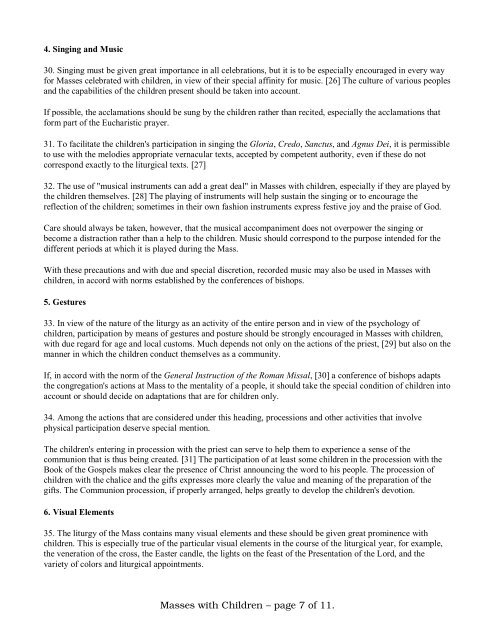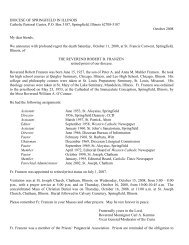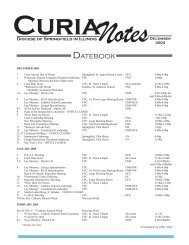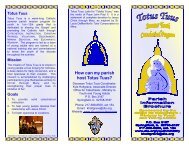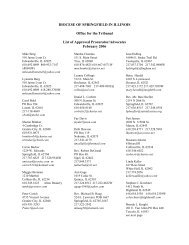Eucharistic Prayers for Masses with Children - Monthly Mailing ...
Eucharistic Prayers for Masses with Children - Monthly Mailing ...
Eucharistic Prayers for Masses with Children - Monthly Mailing ...
Create successful ePaper yourself
Turn your PDF publications into a flip-book with our unique Google optimized e-Paper software.
4. Singing and Music<br />
30. Singing must be given great importance in all celebrations, but it is to be especially encouraged in every way<br />
<strong>for</strong> <strong>Masses</strong> celebrated <strong>with</strong> children, in view of their special affinity <strong>for</strong> music. [26] The culture of various peoples<br />
and the capabilities of the children present should be taken into account.<br />
If possible, the acclamations should be sung by the children rather than recited, especially the acclamations that<br />
<strong>for</strong>m part of the <strong>Eucharistic</strong> prayer.<br />
31. To facilitate the children's participation in singing the Gloria, Credo, Sanctus, and Agnus Dei, it is permissible<br />
to use <strong>with</strong> the melodies appropriate vernacular texts, accepted by competent authority, even if these do not<br />
correspond exactly to the liturgical texts. [27]<br />
32. The use of "musical instruments can add a great deal" in <strong>Masses</strong> <strong>with</strong> children, especially if they are played by<br />
the children themselves. [28] The playing of instruments will help sustain the singing or to encourage the<br />
reflection of the children; sometimes in their own fashion instruments express festive joy and the praise of God.<br />
Care should always be taken, however, that the musical accompaniment does not overpower the singing or<br />
become a distraction rather than a help to the children. Music should correspond to the purpose intended <strong>for</strong> the<br />
different periods at which it is played during the Mass.<br />
With these precautions and <strong>with</strong> due and special discretion, recorded music may also be used in <strong>Masses</strong> <strong>with</strong><br />
children, in accord <strong>with</strong> norms established by the conferences of bishops.<br />
5. Gestures<br />
33. In view of the nature of the liturgy as an activity of the entire person and in view of the psychology of<br />
children, participation by means of gestures and posture should be strongly encouraged in <strong>Masses</strong> <strong>with</strong> children,<br />
<strong>with</strong> due regard <strong>for</strong> age and local customs. Much depends not only on the actions of the priest, [29] but also on the<br />
manner in which the children conduct themselves as a community.<br />
If, in accord <strong>with</strong> the norm of the General Instruction of the Roman Missal, [30] a conference of bishops adapts<br />
the congregation's actions at Mass to the mentality of a people, it should take the special condition of children into<br />
account or should decide on adaptations that are <strong>for</strong> children only.<br />
34. Among the actions that are considered under this heading, processions and other activities that involve<br />
physical participation deserve special mention.<br />
The children's entering in procession <strong>with</strong> the priest can serve to help them to experience a sense of the<br />
communion that is thus being created. [31] The participation of at least some children in the procession <strong>with</strong> the<br />
Book of the Gospels makes clear the presence of Christ announcing the word to his people. The procession of<br />
children <strong>with</strong> the chalice and the gifts expresses more clearly the value and meaning of the preparation of the<br />
gifts. The Communion procession, if properly arranged, helps greatly to develop the children's devotion.<br />
6. Visual Elements<br />
35. The liturgy of the Mass contains many visual elements and these should be given great prominence <strong>with</strong><br />
children. This is especially true of the particular visual elements in the course of the liturgical year, <strong>for</strong> example,<br />
the veneration of the cross, the Easter candle, the lights on the feast of the Presentation of the Lord, and the<br />
variety of colors and liturgical appointments.<br />
<strong>Masses</strong> <strong>with</strong> <strong>Children</strong> – page 7 of 11.


